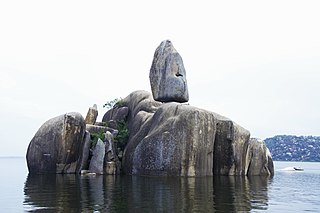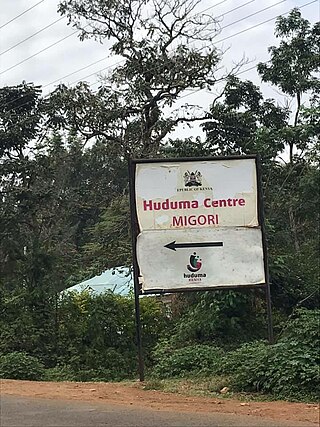Transport in Tanzania includes road, rail, air and maritime networks. The road network is 86,472 kilometres (53,731 mi) long, of which 12,786 kilometres (7,945 mi) is classified as trunk road and 21,105 kilometres (13,114 mi) as regional road. The rail network consists of 3,682 kilometres (2,288 mi) of track. Commuter rail service is in Dar es Salaam only. There are 28 airports, with Julius Nyerere International being the largest and the busiest. Ferries connect Mainland Tanzania with the islands of Zanzibar. Several other ferries are active on the countries' rivers and lakes.

The music of Kenya is very diverse, with multiple types of folk music based on the variety over 50 regional languages.

The Luo, are several ethnically and linguistically related Nilo-Semitic ethnic groups that inhabit an area ranging from Egypt and Sudan to South Sudan and Ethiopia, through Northern Uganda and eastern Congo (DRC), into western Kenya, and the Mara Region of Tanzania. Their Luo languages belong to the western branch of the Nilotic language family.

Kisumu is the third-largest city in Kenya after the capital, Nairobi, and Mombasa. It is the second-largest city after Kampala in the Lake Victoria Basin. The city has a population of slightly over 600,000. The metro region, including Maseno and Ahero has a population of 1,155,574 people according to the 2019 Kenya Population and Housing census which was conducted by the Kenya national Bureau of Statistics.

The Suba (Abasuba) are a heterogeneous Bantu group of people in Kenya with an amalgamation of clans drawn from their main tribes Ganda people, Luhya people, and Soga who speak the Suba language that is closely similar to the Ganda language spare some lexical items borrowed from [[Luo. Their population is estimated at 157,787, with substantial fluent speakers. They migrated to Kenya from Uganda and settled on the two Lake Victoria islands of Rusinga and Mfangano, others also settled on the mainland areas including Gembe, Gwassi, Kaksingri of Suba South and Migori and are believed to be the last tribe to have settled in Kenya. The immigrants to present-day Subaland trace their ancestry among Ganda people, Luhya people, Soga people, and the Luo people. The evidence supporting this is the fact that some Suba groups speak languages similar to Luganda, Lusoga and the Luhya. The Suba groups tracing ancestry among the Kenyan tribes preceded those groups from Uganda in present-day Subaland and are the numerous and influential ones. Those groups from Uganda are mostly concentrated in Rusinga and Mfangano islands with small pockets of them being found in mainland Kenya. Linguistically, the Suba are highly influenced by the neighbouring Luo, to the point of a language shift having taken place among large portions of the mainland Suba. As a result, their own language has been classified as endangered. Despite this language shift, the Suba have kept a distinct ethnic identity. The Rusinga Festival is held in December of every year as a cultural festival to celebrate and preserve Suba culture and language.
Kisuba, also known as Olusuba, is a Bantu language spoken by the Suba people of Kenya. The language features an extensive noun-classification system using prefixes that address gender and number. Suba clans are located on the eastern shore and islands of Lake Victoria in Kenya and Tanzania. They have formed alliances with neighboring clans, such as the Luo people, via intermarriages, and as a result a majority of Suba people are bilingual in Dholuo. The Suba religion has an ancient polytheistic history that includes writings of diverse, ancestral spirits. A recent revival of the Suba language and its culture has influenced the increasing number of native speakers each year.

Benga is a genre of Kenyan popular music. It evolved between the late 1940s and late 1960s, in Kenya's capital city of Nairobi. In the 1940s, the African Broadcasting Service in Nairobi aired a steady stream of soukous, South African kwela, Congolese finger-style guitar and various kinds of Cuban dance music that heavily influenced emergence of benga. There were also popular folk songs of Tanzania and Kenya's Luo peoples that formed the base on benga creation.

Mwanza City, also known as Rock City to the residents, is a port city and capital of Mwanza Region on the southern shore of Lake Victoria in north-western Tanzania. With an urban population of 1,311,000 in 2023, it is Tanzania's second largest city, after Dar es Salaam. It is also the second largest city in the Lake Victoria basin after Kampala, Uganda and ahead of Kisumu, Kenya at least in population size. Within the East African community, Mwanza city is the fifth largest city after Dar, Nairobi, Mombasa, and Kampala. It is slightly ahead of Kigali, Kisumu, and Bujumbura in the population of city proper limits. However, in terms of infrastructure, Kigali and Kisumu cities are way ahead of Mwanza. Mwanza city is also the capital city of Mwanza Region, and is administratively divided into two municipal districts within that Region - Ilemela and Nyamagana.

Musoma is a city in the east shore of lake Victoria of Tanzania. It is the capital of Mara Region, one of the administrative Regions of Tanzania. It also serves as the administrative centre of Musoma Rural District and Musoma Urban District.

Mwanza Region is one of Tanzania's 31 administrative regions The region covers a land area of 25,233 km2 (9,743 sq mi). The region is comparable in size to the combined land area of the nation state of North Macedonia. Mwanza Region is bordered to the north through Lake Victoria by the Kagera Region and Mara Region, to the east by Simiyu Region, to the south by the Shinyanga Region and to the west by Geita Region. The regional capital is the city of Mwanza. According to the 2022 national census, the region had a population of 3,699,872 and national census of 2012 had 2,772,509. Mwanza Region is the second region with high population in Tanzania after Dar es Salaam Region

Kisumu County is one of 47 counties in the Republic of Kenya. Its borders follow those of the original Kisumu District, one of the former administrative districts of the former Nyanza Province in western Kenya. Its headquarters is Kisumu City which is the third largest city in Kenya after the capital Nairobi and the coastal city of Mombasa. It has a population of 1,155,574. The land area of Kisumu County totals 2085.9 km2.
The Dholuo dialect or Nilotic Kavirondo, is a dialect of the Luo group of Nilotic languages, spoken by about 4.2 million Luo people of Kenya and Tanzania, who occupy parts of the eastern shore of Lake Victoria and areas to the south. It is also spoken by millions in Uganda, South Sudan, and Ethiopia. It is used for broadcasts on Ramogi TV and KBC.
The Suba of Tanzania are a community of people in Rorya District, Mara Region, Tanzania speaking mutually intelligible varieties of the Suba language. They are mainly located in Nyancha, Luo-Imbo and Suba Divisions of Rorya District. The groups commonly listed as being part of the Suba community are the Hacha, Kine, Rieri, Simbiti, Surwa and Sweta. There are a total of around 80,000 ethnic Suba living in Tanzania, most of whom are still speaking the Suba language although some, particularly the Rieri, have started to speak Luo.
Daniel Owino Misiani was a Tanzanian-born musician based in Kenya, where he led the Shirati Jazz collective. He was known as the "King of History" in Kenya; overseas and in Tanzania, he was known as "the grandfather of benga", which he pioneered.

The Kuria people (also known as the AbaKurya, are a Bantu community in Tarime District of Mara Region in Tanzania and southern Kenya. Their homeland is bounded on the east by the Migori River and on the west by the Mara River estuary. Traditionally a pastoral and farming community, the Kuria grow maize, beans and cassava as food crops and coffee and maize as cash crops.

Migori, also known as Suna-Migori, is a multi-ethnic municipal town which acts as the capital of Migori County, Kenya. The town is located 63 kilometers south of Kisii town and 22 km north of the Tanzanian border. The Migori Metropolitan area consists of Migori municipality and the adjacent smaller towns. The area has three constituencies, namely Suna East, Suna West and Uriri, with a total population of 393,012 according to the Kenya National Bureau of Statistics-sponsored national census of 2019. The neighboring town/constituency of Awendo has 96,872 and Kuria East (Sirare) has 117, 290. In 2010, The Star newspaper reported that the town (proper) had a population of approximately 100,000 people.

Migori County is a county in the former Nyanza Province of southwestern Kenya. It borders Homa Bay County to the north, Kisii County to the northeast, Narok County to the southeast, Tanzania to the west and south, and Lake Victoria to the west. The county also borders Uganda via Migingo Island in Lake Victoria. The county is headquartered by Migori, which is also its largest town. At the 2019 census, Migori County had a population of 1,116,436, almost 200,000 more than the 917,170 recorded in 2009.

Rorya District is a district in Mara Region, United Republic of Tanzania. The district capital is the small town of Ingri Juu, while the largest town is Shirati. The district was created in 2007 from a part of Tarime District. It is bordered by Tarime District to the east, Butiama District to the south, Lake Victoria to the west, and the Republic of Kenya to the north. The majority of inhabitants are from the Luo tribe. Other ethnic group is Kurya. Kine, Simbiti,Sweta and Hacha are sub-groups within Kurya ethnic group.

Karungu (Karunga) is a village in Kenya on the shore above Lake Victoria, near the frontier with Tanzania. Administratively it is in Karungu Location, Karungu Division, Migori County.

Thimlich Ohinga is a complex of stone-built ruins in Migori county, Nyanza Kenya, in East Africa. It is the largest one of 138 sites containing 521 stone structures that were built around the Lake Victoria region in Kenya. These sites are highly clustered. The main enclosure of Thimlich Ohinga has walls that are 1–3 m (3.3–9.8 ft) in thickness, and 1–4.2 m (3.3–13.8 ft) in height. The structures were built from undressed blocks, rocks, and stones set in place without mortar. The densely packed stones interlock. The site is believed to date to the 15th century or earlier.













